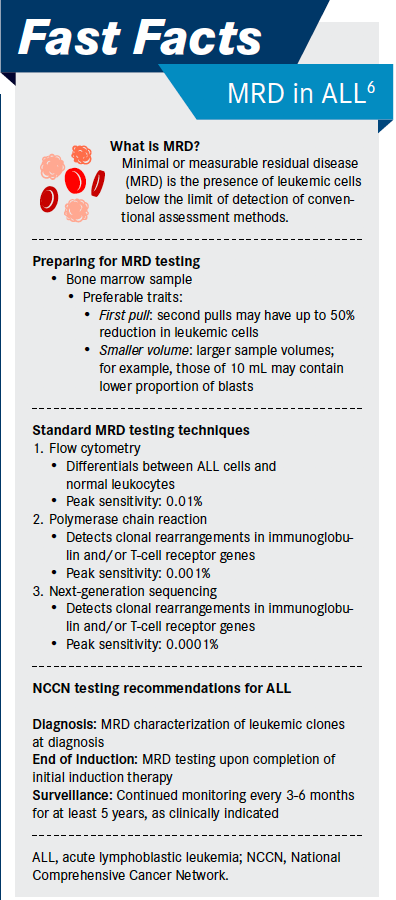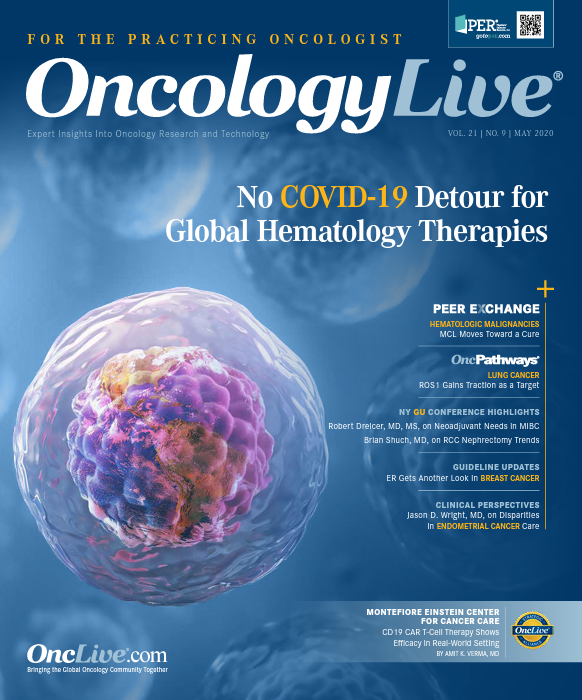MRD in Acute Lymphoblastic Leukemia: Why, How, When, and Whom to Test?
During a recent OncLive Peer Exchange®, a panel of experts in adult and pediatric leukemias provided an update on minimal residual disease testing in acute lymphoblastic leukemia.
Mark R. Litzow, MD

Advancements in the treatment landscape for adult patients with acute lymphoblastic leukemia (ALL) has led to improved rates of complete remission at some point during their treatment course. But although 80% to 90% achieve complete remission, 50% of adult patients ultimately experience relapse and have poor outcomes.1 Studies in both adult and pediatric patients with ALL have demonstrated a strong correlation between minimal or measurable residual disease (MRD) and risk for relapse, leading investigators to explore the prognostic significance MRD holds for this patient population.2
Patients with ALL who achieve complete remission can potentially harbor a large number of leukemic cells in the bone marrow below the threshold of detection of conventional morphologic assessment.2 For example, in pediatric patients where ALL accounts for approximately 80% of leukemia cases, 25% to 50% of patients may have detectable MRD following induction therapy, leading to a shorter time to relapse.
During a recent OncLive Peer Exchange®, a panel of experts in adult and pediatric leukemias provided an update on MRD testing in ALL. They shared their insights into why MRD testing is important and strategies for ensuring a high-quality test result. They also examined when testing should be undertaken and reviewed who should be tested. “ALL is now the first hematologic neoplasm for which assessment of early response to therapy by MRD monitoring has proven to be a fundamental tool for guiding therapy….[It is] a key component in individualizing care for each patient,” said moderator Mark R. Litzow, MD.
Why MRD Testing Is Important
The panelists discussed a variety of prognostic factors that need to be taken into consideration when caring for patients with ALL, including demographic, clinical, and biologic/genetic factors, as well as patients’ response to treatment.3,4 “We still need to consider the individual patient…but I think we’re finding that measurable residual disease is replacing some of our traditional risk factors that we’ve relied on in the past,” Litzow said.
MRD refers to the presence of leukemic cells below detectable levels when assessed with conventional morphologic methods and has been shown to be a useful prognostic tool in clinical studies.1,5 “We initially called this minimal residual disease, but people are moving to call this measurable residual disease. I like that term because it reminds me that all the tests we use have levels of detection, and people who are MRD negative can relapse. We know that they still have residual disease there, it’s just too low for our limits of detection,” Litzow said.
There is no consensus on what sensitivity threshold indicates MRD positivity but at least 1 cancer cell in 10,000 normal cells (≥0.01%) is commonly used.6 A 2017 meta-analysis that included 13,637 adult and pediatric patients found MRD status to be a strong indicator of therapeutic benefit, noting “minimal residual disease is a biomarker of disease in the powerful sense that MRD is the disease.”5 Patients who became MRD negative early in the course of treatment had a reduced risk of relapse and were more likely to have longer overall survival. The 10-year event-free survival for patients who achieved MRD negativity versus those who did not was 64% versus 21% for adult patients and 77% versus 32% for pediatric patients. The value of achieving MRD was consistently observed across therapies, disease subtypes, and MRD assessment methods, time performed, and sensitivity threshold.5
How to Ensure a High-Quality MRD Test Result
MRD testing requires obtaining a high-quality sample from the patient’s bone marrow. The panelists explained that the highest-quality sample comes from the first pull of the marrow aspirate, with a 2-mL or 3-mL sample after the needle is introduced into the bone marrow being ideal. “You don’t want that first pull to be 10 mL and just hemodiluted,” panelist Ryan D. Cassaday, MD, said.
Having to undertake subsequent pulls also compromises the MRD result. A 50% reduction in leukemic cells has been observed in samples from second pulls.6 As the number of pulls increases, there is increasing dilution of leukemic cells. “If there is total dilution of the sample, it is no longer really relevant for testing,” panelist Jae Park, MD, said. Subsequently, if the oncologist is not the one obtaining the bone marrow aspirate for evaluation, Park recommended discussing the importance of obtaining a good specimen on the first pull with the provider performing the procedure.
Another important consideration the panelists discussed is knowing where the specimen is going to be tested and which test is being used. “The most common tool or method used to measure MRD, at least in the United States, is multiparameter flow cytometry. It’s fast and relatively reliable,” Cassaday said. Flow cytometry differentiates ALL cells from normal leukocytes. However, because of variability in technique, the sample should be assessed at a facility that provides excellent, reference-laboratory quality flow cytometry, such as the type offered by the University of Washington, he noted. “If it’s being run as an in-house assay, it’s worth talking to the pathologists about,” he said, noting it would be important to ask questions about the sensitivity of the assay and how many colors are being used. To detect leukemic cells at a sensitivity threshold of less than 0.01%, at minimum a 6-color flow cytometry needs to be performed.2 “If the level of sensitivity is 0.1% or worse, it’s going to be very hard to be able to utilize the data for MRD-directed therapy because you’re going to be falsely reassured,” he said.
Other standard techniques for MRD testing include polymerase chain reaction (PCR) and next-generation sequencing (NGS), which can detect leukemic cells at a sensitivity threshold of less than 1 × 10-6 (<0.0001%).1 “In Europe they base a lot of their MRD assessments on PCR. It’s a more labor-intensive strategy, but it tends to be more sensitive when done in proper laboratories,” Cassaday said. PCR detects clonal rearrangements in immunoglobulin (Ig) heavy chain genes and/or T-cell receptor (TCR) genes and can detect gene fusions such as BCR-ABL1.2 “They worked out a system to standardize and then centralize [MRD assessment] that we just don’t have here in the United States. One exception to that is probably the BCR-ABL quantitative PCR that we can use for Ph [Philadelphia chromosome]-positive patients and a few other examples of fusion oncogenes that we can use for RT-PCR [reverse transcriptase PCR] that are probably more reliably sensitive than most standard flow cytometry,” he said.
NGS is the newest modality being used to assess MRD. Like PCR, it detects clonal rearrangements in Ig heavy chain genes and/or TCR genes.1 “You have to have a [baseline] specimen from the leukemia to be able to identify the sequence, which is not necessarily an assured thing. And it takes a little bit more of a turnaround time,” Cassady explained. Compared with flow cytometry, which can yield results in less than 1 day, NGS results may take up to a week.6 He also noted that it is not yet clear how NGS can be used to guide treatment decision making in clinical practice but that “it’s certainly an important and potentially useful tool that is hopefully going to become more integrated into clinical trials so we can use it a bit more reliably.”
When and Whom to Test for MRD
According to Litzow, the National Comprehensive Cancer Network (NCCN) guidelines are used to guide MRD testing in adult patients. These guidelines suggest MRD assessment should be undertaken upon completion of the initial induction and then periodically based on regimen and response.2
“The general timing that we do [when] testing for MRD is after induction 1, which is usually the 4-week time point given whatever regimen they used, whether it’s hyper-CVAD 1a [cyclophosphamide, vincristine, doxorubicin, dexamethasone] versus a pediatric or pediatric-inspired regimen, or some of the other regimens,” Park said. “I think that’s a clear time point to get them tested, but you can argue that on the basis of that 4-week MRD, we don’t necessarily make treatment-change decisions at that time, but it identifies our higher-risk patients,” he said.
Park added that follow-up MRD testing is typically performed at the 3-month mark for most patients, regardless of whether they are getting induction 2, consolidation, or another cycle of hyper-CVAD. “The NCCN guidelines loosely use the term induction. After induction, after initial consolidation, some of these regimens have a long consolidation so I personally check every time I do a bone marrow biopsy, the bone marrow aspiration,” he said. He explained that throughout consolidation, he makes recommendations based on the regimen, with testing generally occurring every 2 or 3 months while patients are being treated.
MRD assessments should also be undertaken during maintenance therapy, but Park explained that testing frequency in this setting has also not been well defined for adult patients. “For certain regimens, they have done protocols every 3 months for the first year and every 6 months for the second year, but it all depends. One thing we want to emphasize is this: If it is not induction 1, consolidation, then you stop monitoring them. If they are MRD positive, then you change the management. If they are MRD negative, you want to follow that MRD level to make sure that those are staying negative to, again, optimize the management based on the level,” he said.
Panelist Rachel E. Rau, MD, said that MRD timing is approached slightly differently in pediatric patients. Although the induction period for pediatric regimens is 4 to 5 weeks, the utility of MRD testing at this time point is lineage dependent. “In B-cell ALL, that early time point is highly prognostic. In T-cell ALL, it takes a little longer to clear [leukemic cells] so it doesn’t seem to have the same impact on outcome, and, therefore, a second time point for the patients with T-cell ALL seems to be most critical in terms of clearance and correlation with outcome,” Rau said. She noted in the patients with T-cell ALL, the second time point for MRD testing is generally after 2 months of additional therapy following induction, although it varies by consortium.
Rau noted that several interesting data in the pediatric population indicate that patients with certain genotypes do well even if their MRD shows leukemic cells above the level associated with more favorable outcomes (ie, >0.01). She explained that a study published by investigators at the University of California found that the patients with favorable cytogenetics tended to do well even if their MRD was slightly higher at the end of induction. Two favorable pediatric cytogenetic subsets include patients with hyperdiploidy and those with ETV6-RUNX1 fusions.7 She noted that when they examined the Children’s Oncology Group data for these patients, they found differences. Patients with hyperdiploidy (ie, double trisomy of chromosomes 4 and 10) and an MRD between 0.1% and 0.01% did fine with standard nonintensified postinduction therapy. In contrast, patients with ETV6/RUNX1 fusions who had an MRD in the same range did not do well unless their postinduction therapy was intensified. “For us, our genotype-specific threshold is for the double trisomy patients. I think it is clean to apply the same threshold to every patient, but that may not necessarily be the case for all,” Rau said.
Innovation Continues But Challenges Remain
The panelists agreed that all patients with ALL should be tested for MRD and that, with testing refinements, the data available to them will increase. “The level of the sensitivity of detection is getting better. We were talking about 10-4 and we have the tools to get much deeper than that, 10-6, and I think it will probably go even deeper soon,” Park said. He also noted that he would like to see testing move away from bone marrow–based testing and see an improvement in the sensitivity of blood-based testing. “More sensitive blood-based testing can hopefully help our patients to lessen the amount of the procedures that they have to go through,” he said.
With more granular information becoming available, the question that remains will become how best to use it in practice. “For that small [amount of] disease, is it worthwhile to intensify or change the therapy that has been previously working or just continue with it? Hopefully, we can address these issues in large trials to really answer them, rather than borrowing the data piecemeal,” Park said.
He noted that patients with T-cell lymphoblastic lymphoma are an exception because they rarely have blood or bone marrow involvement. In these patients, he said, there are no good prognostic tools. “We do PET [positron emission tomography] scan assessment,” he said. Cassady agreed, saying he also uses PET scans in this population at times. “It’s a really challenging population to apply risk-directed therapy and response assessments to. In my experience, fortunately, those patients tend to do pretty well, so transplant is usually not something I’m thinking about for most of those folks, but there is definitely a subset that does not do well and, unfortunately, it’s hard to know who those patients are,” he said.

References
- Typical treatment of acute lymphocytic leukemia (ALL). American Cancer Society. Updated October 17, 2018. Accessed April 27, 2020. bit.ly/2XUvHk2
- National Comprehensive Cancer Network. Clinical Practice Guidelines in Oncology. Acute Lymphoblastic Leukemia (version 1.2020). Updated January 15, 2020. Accessed April 27, 2020. https://www.nccn.org/professionals/physician_gls/ pdf/all.pdf
- Acute lymphocytic leukemia (ALL) subtypes and prognostic factors. American Cancer Society. Updated October 17, 2018. Accessed April 27, 2020. bit.ly/2yvv0CO
- Hunger SP, Mullighan CG. Acute lymphoblastic leukemia in children. N Engl J Med. 2015;373(16):1541-1552. doi:10.1056/NEJMra1400972
- Berry DA, Zhou S, Higley H, et al. Association of minimal residual disease with clinical outcome in pediatric and adult acute lymphoblastic leukemia: a meta-analysis. JAMA Oncol. 2017;3(7):e170580. doi:10.1001/jamaoncol.2017.0580
- MRD at a glance. Amgen Inc. November 2019. Accessed April 27, 2020. bit.ly/3eyf9nT
- Pui CH, Pei D, Raimondi SC, et al. Clinical impact of minimal residual disease in children with different subtypes of acute lymphoblastic leukemia treated with response-adapted therapy. Leukemia. 2017;31(2):333-339. doi:10.1038/ leu.2016.234




